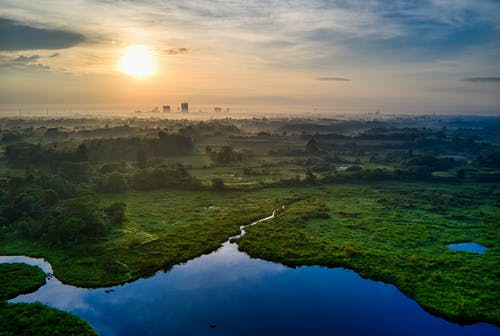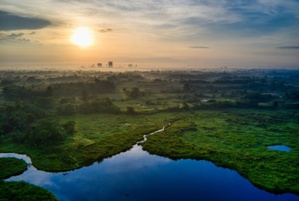Dailycsr.com – 17 May 2019 – The “basic requirements of planting”, which involves sunlight, water, soil and seed, is taught to us in our childhood, therefore it is no surprise that freshwater resources and agriculture are “intrinsically linked”.
According to the World Bank data, 70% of global freshwater consumption is for agriculture alone. General Mills came out with its “Global Responsibility Report” for the year of 2018, wherein it “identified water risk as a material issue”, whereby the company sought to initiate “stewardship plans” which will prioritise on “watersheds across its global value chain”.
TriplePundit got to speak with General Mill’s Applied Sustainability Manager, Jeff Hanratty, about the company’s efforts in identifying and addressing the “key water risks” of agricultural production, whereby explaining the organisation’s focus on “priority watersheds”.
Megan Amrich informs that water problem is an “extremely localized issue” as geographic location presents its “own unique challenges” determining the “quantity and quality of available freshwater”.
Hanratty recounted further that in 2016, General Mills carried out an analysis of “41 watersheds” that affected its supply chain across the globe. In this survey, the company used public tools such as “World Wildlife Fund’s Water Risk Filter and the World Business Council for Sustainable Development’s Global Water Tool”. At the end of this task, General Mills singled out “eight priority watersheds”. While Hanratty added:
“We selected the places around the world that have the highest water risk related to our products. What are the key ingredients we can’t get elsewhere? For example, 80 percent of almonds come from California, so that’s where we need to get almonds. Dairy is also location-specific. It is extremely expensive and labor/energy intensive to transport dairy great distances.”
However, assessing watersheds is a continuous task for General Mills as it regularly keeps a check on them to determine the ones that need “most urgent” focus within its value chain. Assessing future water risks enables the company to implement “changes in products, their ingredients” besides taking “their sourcing geographies into consideration”.
General Mills has set goal of activating “a watershed plan by 2025” in all the “eight priority watershed areas”, which are very different from each other thus binding them with “common goal” would “be counterproductive, if not impossible”. Among the two priority watersheds under General Mills’ water stewardship are:
According to the World Bank data, 70% of global freshwater consumption is for agriculture alone. General Mills came out with its “Global Responsibility Report” for the year of 2018, wherein it “identified water risk as a material issue”, whereby the company sought to initiate “stewardship plans” which will prioritise on “watersheds across its global value chain”.
TriplePundit got to speak with General Mill’s Applied Sustainability Manager, Jeff Hanratty, about the company’s efforts in identifying and addressing the “key water risks” of agricultural production, whereby explaining the organisation’s focus on “priority watersheds”.
Megan Amrich informs that water problem is an “extremely localized issue” as geographic location presents its “own unique challenges” determining the “quantity and quality of available freshwater”.
Hanratty recounted further that in 2016, General Mills carried out an analysis of “41 watersheds” that affected its supply chain across the globe. In this survey, the company used public tools such as “World Wildlife Fund’s Water Risk Filter and the World Business Council for Sustainable Development’s Global Water Tool”. At the end of this task, General Mills singled out “eight priority watersheds”. While Hanratty added:
“We selected the places around the world that have the highest water risk related to our products. What are the key ingredients we can’t get elsewhere? For example, 80 percent of almonds come from California, so that’s where we need to get almonds. Dairy is also location-specific. It is extremely expensive and labor/energy intensive to transport dairy great distances.”
However, assessing watersheds is a continuous task for General Mills as it regularly keeps a check on them to determine the ones that need “most urgent” focus within its value chain. Assessing future water risks enables the company to implement “changes in products, their ingredients” besides taking “their sourcing geographies into consideration”.
General Mills has set goal of activating “a watershed plan by 2025” in all the “eight priority watershed areas”, which are very different from each other thus binding them with “common goal” would “be counterproductive, if not impossible”. Among the two priority watersheds under General Mills’ water stewardship are:
- San Joaquin, California
- Ganges River, Madhya Pradesh, India
The “San Joaquin Valley” is located in the “southern two-thirds of California’s Central Valley” and forms part of the “most productive agricultural regions” in the world wherein grows over “250 types of crops”. The said area is counted among the “important” food suppliers which provide “tomatoes, dairy, raisins and almonds”.
The “2014 Sustainable Groundwater Management Act”, in short SGMA, of California gives out guidelines for restoring “groundwater levels” and preventing “future depletion of stored water”. General Mills has been working with various partners to “make SGMA compliance easier and more impactful”. Furthermore, the company also works with “The Nature Conservancy” and “Sustainable Conservation” to propagate “on-farm groundwater recharge”, while Hanratty:
“Before on-farm groundwater recharge, California farmers could only choose between two options when there wasn’t enough water: Not farming and leaving the land fallow or farming a less valuable crop that requires less water. This opens up new options”.
As for the Ganges River in India, General Mills again collaborates with The Nature Conservancy and attempts to grasp the “challenges and opportunities of wheat farming in the Ganges River Watershed, located in West-Central India”. Talking about Hanratty’s visit to this area in 2018, he said:
“It is not that these regions don’t get rain—they receive more than 39 inches of annual rainfall in a normal year—but almost 90 percent falls in the monsoons (from June to September). With existing water storage infrastructure and the lack of available groundwater, the farmers run out of water by January, although they harvest the wheat in March.”
Since farmlands owned by farmers in India tend to be smaller in size in comparison to an American wheat farm, as the former inherit their land which undergoes further division among his children. Therefore, joining hands in the investment for a “large water management systems” could enable them to not only share their financial burden but also to share their best practices. In Hanratty’s words:
“The most critical success factor [is] cooperation amongst farmers to organize and share resources. Every farmer we interviewed said if they had more water, and better water management resources, their yields would improve and, in turn, their livelihoods.”
References:
3blmedia.com


 Addressing The ‘Extremely Localized Issue’ Of Water Risks
Addressing The ‘Extremely Localized Issue’ Of Water Risks





 Companies
Companies